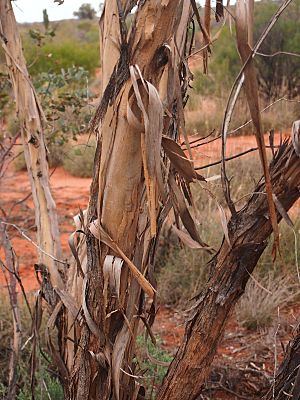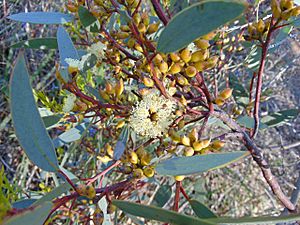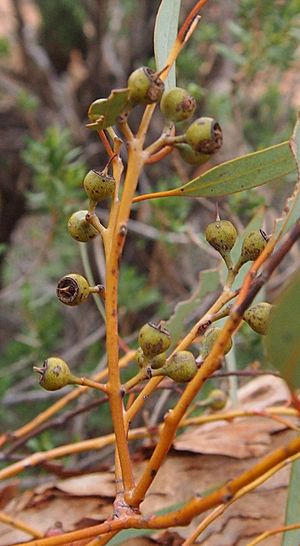Pointed mallee facts for kids
Quick facts for kids Pointed mallee |
|
|---|---|
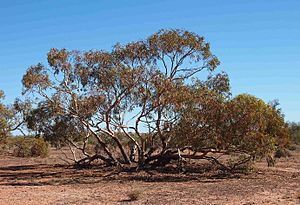 |
|
| Eucalyptus socialis | |
| Scientific classification | |
| Genus: |
Eucalyptus
|
| Species: |
socialis
|
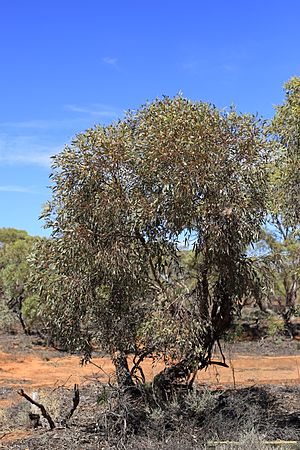
Eucalyptus socialis, often called the Pointed Mallee, Red Mallee, or Grey Mallee, is a unique type of eucalypt tree that grows only in inland Australia. It's a very common and important plant in many dry parts of the country.
Contents
What is the Pointed Mallee?
The Pointed Mallee is a type of mallee, which means it's a eucalypt that usually has many stems growing from a large, woody base underground called a lignotuber. It typically grows to be about 5 to 7 meters (16 to 23 feet) tall, but some can reach up to 12 meters (39 feet)! Its leafy top, called a canopy, can spread about 5 meters (16 feet wide).
This tree usually has rough, grey bark on its main stems. Higher up, the bark is smooth and dull grey, and it peels off in long strips. Young plants have stems that are square-shaped. Their leaves are dull green to greyish, shaped like an egg or a spear, and are about 4 to 8 centimeters (1.6 to 3.1 inches) long and 1.8 to 4.2 centimeters (0.7 to 1.7 inches) wide.
Adult leaves are arranged alternately along the stem. They are the same dull green or greyish color on both sides, shaped like a spear, and measure about 5 to 14 centimeters (2 to 5.5 inches) long and 1 to 2.2 centimeters (0.4 to 0.9 inches) wide. They narrow down to a stalk called a petiole, which is about 1 to 3 centimeters (0.4 to 1.2 inches) long.
The flowers of the Pointed Mallee grow in groups of seven to thirteen. These groups are found where the leaves meet the stem. Each group is on a stalk called a peduncle, which is about 4 to 23 millimeters (0.16 to 0.9 inches) long. The individual flower buds are on smaller stalks called pedicels, about 3 to 8 millimeters (0.12 to 0.31 inches) long.
When the buds are ready to open, they are oval or spindle-shaped, about 8 to 17 millimeters (0.31 to 0.67 inches) long and 3 to 5 millimeters (0.12 to 0.20 inches) wide. They have a pointy or horn-shaped cap called an operculum, which is about 5 to 12 millimeters (0.20 to 0.47 inches) long. The Pointed Mallee can flower almost any time of the year, and its flowers are usually white to pale yellow.
After flowering, the tree produces woody, urn-shaped or round fruits. These fruits are called capsules and are about 4 to 9 millimeters (0.16 to 0.35 inches) long and 4 to 8 millimeters (0.16 to 0.31 inches) wide. Inside, the parts that hold the seeds are enclosed, but a small, fragile part of the flower's style might still be seen sticking out.
How Scientists Name Plants
The scientific name Eucalyptus socialis was first officially described in 1856 by Friedrich Anton Wilhelm Miquel. He used notes from an earlier, unpublished description by Ferdinand von Mueller.
The word socialis comes from Latin and means "friendly." This name was chosen because this eucalypt often grows together with other eucalypt species in mallee forests.
In 2005, a scientist named Dean Nicolle identified four different types, or subspecies, of E. socialis. These are:
- Eucalyptus socialis subsp. eucentrica: This type has a waxy coating on its small branches and flower buds. Its adult leaves are a dull bluish color.
- Eucalyptus socialis subsp. socialis: This is the original type. It has smaller leaves, buds, and fruits than the other subspecies, and its flowers are creamy white.
- Eucalyptus socialis subsp. victoriensis: This type has larger leaves, flower buds, and fruits compared to the others. Its flowers are cream to pale yellow.
- Eucalyptus socialis subsp. viridans: This subspecies is mainly known for its green leaves, which are not bluish-green like some of the others.
Sometimes, E. socialis can even mix with another eucalypt called E. gillii. This mixing, called hybridisation, happens a lot in certain areas like the Barrier Range in New South Wales.
Where Does the Pointed Mallee Grow?
The Pointed Mallee is one of the most common mallee species across Australia. You can find it in many different states and territories.
In Western Australia, it grows on flat areas with limestone and on rocky slopes. It likes red-grey soil that sits over limestone.
It's also very common throughout much of South Australia, especially in southern areas like the Eyre Peninsula, Gawler Range, Flinders Ranges, and the Adelaide foothills.
The tree's range extends north into the southern part of the Northern Territory, around the Alice Springs region. It also grows in parts of Queensland in open woodlands. Here, it often grows alongside other eucalypts like E. dumosa, E. gracilis, and E. leptophylla.
In New South Wales, you can find it west of Condoblin and in scattered spots around Wilcannia. In these areas, it grows in mallee shrubland communities on red, wind-blown sands.
Finally, in Victoria, the Pointed Mallee is found in the north-west part of the state.
Life Cycle and Survival
The Pointed Mallee is very good at surviving bushfires. If a bushfire scorches all its leaves, the tree can often grow back from its base. Less than 30% of these trees die after a fire, showing how tough they are!
Why This Tree is Important
The Pointed Mallee is useful for many reasons. It can produce a lot of biomass, which is plant material that can be used for energy. It can grow about 10 to 20 metric tons (11 to 22 short tons) of biomass per hectare each year.
In farming areas, especially those that grow wheat, this tree is very helpful. It can reduce salinity (saltiness) in the soil, provide shade for farm animals, act as a windbreak to protect crops, and help stop soil erosion.
Traditional Uses
Indigenous Australian people have used the Pointed Mallee for a long time. They used its leaves to make medicines and bowls. They also used the bark to make shields and spears. In dry times, they could even get water from the tree's roots.
Growing Pointed Mallee
You can buy Pointed Mallee plants from nurseries. They are known for being able to grow well even in poor soils. When the tree flowers, it attracts many bees and butterflies, which come to feed on its nectar from spring to summer.
This tree is also very good at handling drought (long periods without rain) and salty conditions. It grows best in full sun and in soil that drains well. While it grows slowly, it's often used in projects to bring plants back to an area (revegetation) and makes a nice small tree for gardens.


